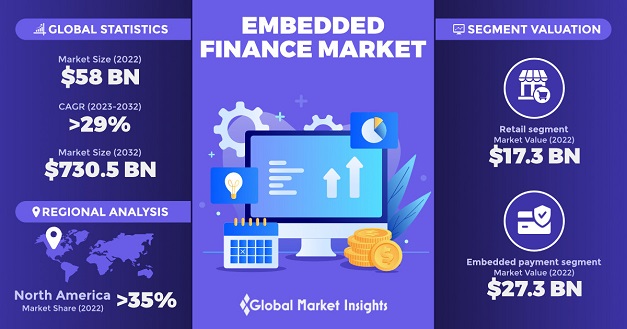Home > Media & Technology > Next Generation Technologies > Fintech > Embedded Finance Market
Embedded Finance Market Size
- Report ID: GMI7054
- Published Date: Oct 2023
- Report Format: PDF
Embedded Finance Market Size
Embedded Finance Market size was valued at USD 58 billion in 2022 and is estimated to register a CAGR of over 29% between 2023 and 2032. The surge in digital payments is driving the market growth by fostering the seamless integration of financial services into various platforms. As consumers increasingly opt for digital transactions, businesses are leveraging this trend to offer integrated financial products, such as digital wallets, lending services, and payment gateways, within their applications.
According to the Press Information Bureau (India) January 2023 press release, BHIM UPI became the favored payment method among citizens, witnessing a remarkable 8036.0 million digital payment transactions totaling USD 165.2 billion in value. The increased adoption of digital payment methods is expanding the embedded finance industry ecosystem, providing convenient, accessible, and tailored financial solutions to a broader audience.
| Report Attribute | Details |
|---|---|
| Base Year: | 2022 |
| Embedded Finance Market Size in 2022: | USD 58 Billion |
| Forecast Period: | 2023 to 2032 |
| Forecast Period 2023 to 2032 CAGR: | 29% |
| 2032 Value Projection: | USD 730.5 Billion |
| Historical Data for: | 2018 - 2022 |
| No. of Pages: | 230 |
| Tables, Charts & Figures: | 287 |
| Segments covered: | 230 |
| Growth Drivers: |
|
| Pitfalls & Challenges: |
|
The demand for frictionless customer experiences in payments is primarily driving the embedded finance market size. Consumers now expect seamless and convenient payment processes across various platforms. To meet customer expectations, businesses are integrating financial services directly into their applications, offering services such as digital wallets, instant loans, and streamlined payment gateways. The focus on enhancing user experience boosts customer satisfaction along with fueling market expansion, creating a more user-friendly & efficient financial landscape.
The integration of financial services into various platforms raises significant concerns about data security and privacy. The handling of sensitive financial information within different applications increases the risk of data breaches and cyberattacks. Protecting customer data from unauthorized access and ensuring compliance with data protection regulations, such as GDPR in Europe, is of prime importance. Establishing robust encryption protocols, multi-factor authentication, and continuous monitoring are the essential measures to mitigate data security challenges and build trust among users in embedded finance services.

